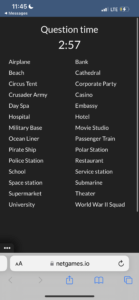Name of game, creator, platform: Spyfall, netgames.io, https://netgames.io/games/spyfall/
Target audience: Ages 13+
Notable elements of the game: how many players? What actions can players take? How do rounds work? Do they do anything interesting with player relationships/objectives/resources? (refer to Formal Elements for this!):
Spyfall is played with 3-8 players. At the beginning of each round, players discover their role for that round (either Spy, 1 person, or not Spy) and if they are not the Spy, they discover the secret location for that round. Participants then take turns asking each other questions. The players who know the location are trying to determine who the Spy is and the Spy is trying to determine what the secret location is from the questions. There is limited player interaction in this section other than the questions. The Spy wins if they can guess the location, and the rest of the group wins if they guess who the Spy is before they get the location.
Compare the game you chose to other games in its genre. What differentiates it from the other games? Is it better/worse? How so?
This game is in the category of social deception games. Spyfall felt more structured than Mafia, another social deception game. There were also fewer group interactions and tensions, as the online version of Spyfall had each player vote for the Spy on their own phone rather than having a group discussion and having to reach consensus, which is how Mafia is sometimes played. I prefer similar games that have a more fluid, social element of group interaction with more opportunity for spontaneity and storytelling.
Was the game fun? Why or why not?
I played the game with 4 total players. Playing the game was fun and socially satisfying in many ways but the experience would have been more fun with more players, as it is harder to ‘hide’ as the spy without more players to gather information from. A few elements that made playing the game particularly enjoyable was meeting eye contact with a fellow player after they asked a particularly deceitful or funny question, giggling with the group, and developing inside jokes based on questions people asked – for example, in the first round a friend asked “Can you eat there?” about a Space Station secret location, which became a group meme, and I reused the phrase ironically when we had Restaurant as a later secret location. These fun experiences of camaraderie underscore feelings of Fellowship, a game Aesthetic principle from MDA. To further encourage this social engagement and fun, I would suggest that the game should be played in an open circle of people, since it was challenging to see the faces of and engage with some players who were across the table my group played off, which contributed to a feeling of being constricted.
Moments of particular success or epic fails (in your opinion)
A moment of ‘failure’ occurred when we first started playing the game and a teammate accidentally revealed she was not the Spy by saying out loud she needed a moment to remember the word on her card, not realizing that the Spy would not have a word on their card.
Things you would change to make the game better
In terms of changing the game itself, I would add a more delightful or visually interesting presentation of the secret location, as the online version just presented the word without any visualization of the location. It would also spice up the game to have more unique secret locations (see screenshot for the basic location list used in the online version) or maybe even provide an opportunity for players to add their own locations to the list, as it could get boring using the same locations after a while. Another fun twist to avoid the game getting boring after playing for a while would be to impose creative constraints on the questions, like participants only being able to ask “yes or no” questions.




